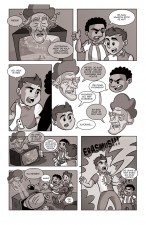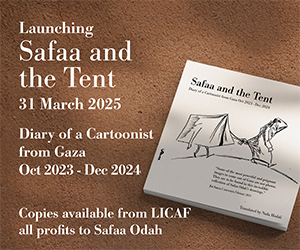Marvel Comics was a household name even in the Netherlands in the sixties and seventies. Dutch translations of Thor, Namor, X-Men, Daredevil, Avengers etc were published by Classics Netherlands under the Hip Comics imprint. Published to test the waters for superhero comics in Belgium and the Netherlands, every HIP Comic contained one superhero, for example, Thor, while the next could feature the X-Men. This went on from 1966 to 1971, until Classic Comics decided to publish separate series for the more popular superheroes.
A digest-sized Kirby and Lee Avengers paperback from Classics Comics was my first introduction to superhero comics back in the early eighties, so imagine my surprise when I saw new HIP Comics lying on a small-press table at a comics convention recently. Continuing the numbering from the seventies edition, the new HIP Comics, published by Windmill Comics Publishing, continued the adventures of then popular heroes, but re-invented for the new generation and under a new guise since, Marvel and DC Comics do own the copyright to their characters of course.
So born was Nicky Tesla, inspired by Kirby’s Kamandi; Western Classics, inspired by Two-Gun Kid and Rawhide Kid; Donar, inspired by Kirby’s Thor; Durfal, inspired by Daredevil; and The Bat, inspired by… well that should be obvious. With art styles ranging from cartoony to Kirby-inspired like Tom Scioli, HIP Comics is back!
BROKEN FRONTIER: The most obvious question of course would be: who is Windmill Comics Publishing?
JOHAN DE NEEF: Windmill Comics is an ever-growing collective of writers and artists who want to grow from amateur to professional status. A few of us are already well on the way to reaching this goal, so Windmill Comics seems at least to be a solid starting point for ambitious creators.
How did WCP come into existence?
Purely by accident, actually. I had started my own comic shop carrying the Windmill Comics name. After about half a year, Gerard van de Werken – whom I had never met before – walked into my store, we started talking and he shared his dream of drawing a comic. I wrote a 12-page script for him and a short while later, he showed me some pencil pages. He immediately knocked me out with the quality of his pencils.
12 pages does not make a comic, however, so I approached Rik van Niedek. I already knew Rik and was aware of his drawing abilities. He also always likes a good challenge, so I wrote another 12-page script and half a year later, in March 2009, we debuted at the comic festival in Breda (Netherlands) with TOO: The Owl Organization. Ramon Schenk contributed as editor, famed comic letter hack Olav Beemer as letterer and Erica Muizer and Ronald van Duuren were the colourists of our first comic.
How did you arrive at the idea of continuing the Classics comics that published books like Kirby’s Avengers and Thor with your own version of HIP Comics?
In small-press circles, TOO #1 was a pretty big success. Within three weeks we sold around 300 comics, so we felt like we were on top of the world and wanted to copy this success into the future. Rik van Niedek suggested we revive HIP Comics.
I already had the rights to The Bat, a Dutch creation from the fifties of Albert Winands, so we just needed to check the availability of the publishing rights of HIP Comics. After a few months it became clear that no-one owned them, so at the comics convention FACTS in 2009, we presented our first HIP Comics with The Bat, Steven de Rie’s Silent Witness and Ramon Schenk and Rik van Niedek’s origin story for TOO member Forrest.
So apart from continuing the numbering, is there any other link between the old and new HIP Comics?
In terms of characters, no, but in terms of what we’re trying to accomplish, yes. In the old HIP Comics you found Marvel Comics stories, but now they have been replaced by superheroes from the Netherlands.
What attracts you so to the Silver Age of comics?
Rik and myself are over fifty and we grew up with the Silver Age. Ramon also has a fond love for comics from that time period (though his love for the Golden Age is even greater). So obviously we wanted to grab that nostalgic feeling and make something productive out of it.
And what makes you respond so much to the style of Jack Kirby and Stan Lee?
To be completely honest, I’m not that big of a Kirby fan, though I find his achievements quite impressive. Rik and Ramon are big Kirby fans, though, as you can see by Rik’s drawing style.
Do you feel that contemporary comics can learn a thing or two by studying the Silver Age?
I don’t think there is much wrong with comics today apart from the fact that it is pretty dark and definitely more violent since Image Comics appeared on the scene. In the States there seems to be less leeway in what creators are allowed to do, especially with DC Comics and Marvel Comics.
Windmill Comics publishes a rather eclectic mix of comics that harken back to the fifties, sixties and seventies but also comics that reflect the current times.
Who are some of your favourite artists?
I would say Neal Adams, and from the current crop of artists Ivan Reis. Rik and Ramon are big fans of Gil Kane, Steve Ditko and Wally Wood.
How do you find the creators for your comics and judge the material?
The original concepts came into being in a variety of ways. I had written and drawn about six comics of TOO in the seventies, not because I was that good but I just felt like doing it. Gerard and Rik later then realised my dream by making them actually look good when published.
Copperhead Kid in Sheriff Classics and Nicky Tesla in Adventure Classics came from Rik and Ramon’s love of old western comics and Kirby’s Kamandi and Samson, but obviously there’s also a dash of Planet of the Apes.
The UC Masters comic came about because in the nineties, Ramon and I (together with Marlous Smit and Chris Krone) published the fanzine Universal Comics Magazine. In one edition we had a competition to draw all the publishers as superheroes and it was won by Romano Molenaar, who went on to draw Batman for DC Comics and Storm from Don Lawrence. Anyway, that entry was the basis for The UC Masters Comic.
Captain Roffa was developed with the drawing style of Boy Akkerman in mind. But we also spontaneously run into talent like Ulrik Nilsson and Annette de Goeij, while I have known other talents like Steven de Rie, Rik van Niedek and Ramon Schenk for several years. There is of course also the Internet, and artists sometimes bring in other people they know.
What do you look for in a comic you want to publish?
We feel it is important that a comic creator has fun with creating comics, because this fun most likely translates into reading pleasure for our buyers, and hopefully they will like it.
What are your thoughts on the current state of the industry in the Netherlands?
It’s in a bit of a flux, I’d say. Small-press publishers come and go pretty quickly, like Hellene Press and Drop Comics, but Koper Comics seems to be doing well and I have high expectations of the new kid on the block, Mesj Media.
Then there’s RW/Lion, who are being rather successful with their translations of DC Comics, so I’m hoping that the amount of Dutch comics will be rising in the coming years.
So what can we expect from Windmill Publishing in 2015?
Lots and lots of stuff! There’s HIP Comics Annual #3, with three different covers (Rik van Niedek, Cindy Soumeru and Annette de Goeij) and with Rik van Niedek and Dinesh van den Berg as artists for the interiors.
There are about three or four new HIP Comics, with the debut of Durfal (the golden age Daredevil) with artwork by Rik and Gerard. TOO’s Night-Owl will feature our new artist, Daniel Arruda Massa. Sheriff Classics will have a new comic, as well as Nicky Tesla. There’s the new Super Comics with Captain Roffa, featuring Boy (Boykoesh) Akkerman and newcomer Stefan Haas.
The Erasmus Comics imprint will publish the final part of the Muse cyclus by Ulrik Nilsson and probably New Dawn by Rodney Roger. And a new Shock Classics will see the light of day in 2015.
So we have a big year ahead, since we expect to publish about 20 or 25 comics in 2015!
Visit Windmill Comics at their website to learn more about their comics. If you want to learn more about HIP Comics in the sixties, there’s quite a detailed fan website right here.
For more news & info from Europe’s comics community, follow me on Twitter.






























